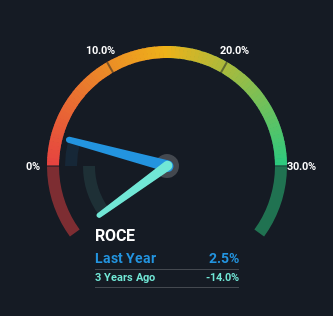- Hong Kong
- /
- Food and Staples Retail
- /
- SEHK:8413
Be Wary Of Asia Grocery Distribution (HKG:8413) And Its Returns On Capital
What financial metrics can indicate to us that a company is maturing or even in decline? Typically, we'll see the trend of both return on capital employed (ROCE) declining and this usually coincides with a decreasing amount of capital employed. Basically the company is earning less on its investments and it is also reducing its total assets. And from a first read, things don't look too good at Asia Grocery Distribution (HKG:8413), so let's see why.
Return On Capital Employed (ROCE): What Is It?
For those that aren't sure what ROCE is, it measures the amount of pre-tax profits a company can generate from the capital employed in its business. To calculate this metric for Asia Grocery Distribution, this is the formula:
Return on Capital Employed = Earnings Before Interest and Tax (EBIT) ÷ (Total Assets - Current Liabilities)
0.025 = HK$2.6m ÷ (HK$128m - HK$26m) (Based on the trailing twelve months to September 2024).
Therefore, Asia Grocery Distribution has an ROCE of 2.5%. In absolute terms, that's a low return and it also under-performs the Consumer Retailing industry average of 7.3%.
Check out our latest analysis for Asia Grocery Distribution

While the past is not representative of the future, it can be helpful to know how a company has performed historically, which is why we have this chart above. If you want to delve into the historical earnings , check out these free graphs detailing revenue and cash flow performance of Asia Grocery Distribution.
What Can We Tell From Asia Grocery Distribution's ROCE Trend?
In terms of Asia Grocery Distribution's historical ROCE movements, the trend doesn't inspire confidence. To be more specific, the ROCE was 3.8% five years ago, but since then it has dropped noticeably. Meanwhile, capital employed in the business has stayed roughly the flat over the period. This combination can be indicative of a mature business that still has areas to deploy capital, but the returns received aren't as high due potentially to new competition or smaller margins. So because these trends aren't typically conducive to creating a multi-bagger, we wouldn't hold our breath on Asia Grocery Distribution becoming one if things continue as they have.
On a side note, Asia Grocery Distribution's current liabilities have increased over the last five years to 20% of total assets, effectively distorting the ROCE to some degree. Without this increase, it's likely that ROCE would be even lower than 2.5%. While the ratio isn't currently too high, it's worth keeping an eye on this because if it gets particularly high, the business could then face some new elements of risk.
What We Can Learn From Asia Grocery Distribution's ROCE
All in all, the lower returns from the same amount of capital employed aren't exactly signs of a compounding machine. This could explain why the stock has sunk a total of 77% in the last five years. That being the case, unless the underlying trends revert to a more positive trajectory, we'd consider looking elsewhere.
One more thing to note, we've identified 2 warning signs with Asia Grocery Distribution and understanding these should be part of your investment process.
While Asia Grocery Distribution may not currently earn the highest returns, we've compiled a list of companies that currently earn more than 25% return on equity. Check out this free list here.
New: Manage All Your Stock Portfolios in One Place
We've created the ultimate portfolio companion for stock investors, and it's free.
• Connect an unlimited number of Portfolios and see your total in one currency
• Be alerted to new Warning Signs or Risks via email or mobile
• Track the Fair Value of your stocks
Have feedback on this article? Concerned about the content? Get in touch with us directly. Alternatively, email editorial-team (at) simplywallst.com.
This article by Simply Wall St is general in nature. We provide commentary based on historical data and analyst forecasts only using an unbiased methodology and our articles are not intended to be financial advice. It does not constitute a recommendation to buy or sell any stock, and does not take account of your objectives, or your financial situation. We aim to bring you long-term focused analysis driven by fundamental data. Note that our analysis may not factor in the latest price-sensitive company announcements or qualitative material. Simply Wall St has no position in any stocks mentioned.
About SEHK:8413
Asia Grocery Distribution
An investment holding company, trades in and distributes food and beverage grocery products under Hung Fat Ho brand name in Hong Kong.
Flawless balance sheet and fair value.
Market Insights
Community Narratives



